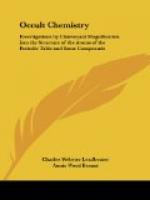The central globe, dividing into eight, becomes eight six-atomed spheres on the meta, the “cigar” behaving as usual, four “cigars” being positive and four negative, and becoming dissociated into triplets; the four atoms within the heart-shaped body appear as a tetrahedron, remain together on the meta level, and break up into duads on the hyper.
STRONTIUM (PLATE VIII, 3).
The third member of this group repeats the a groups of beryllium and the b groups of calcium, and they dissociate into the bodies already described under these respectively. The two upper globes in each funnel repeat each other, but each globe contains four smaller spheres showing three varieties of forms. The two marked g, which are repeated in the central globe as h, are seven-atomed, and appear as spheres or ovoids according to pressure. They are figured on p. 48, under iodine; e and f are related as object and image, and we have already seen them in copper (pp. 38 and 48); in each case, as in copper, they unite into a ten-atomed figure; on the meta level the pair of fours form a ring, and the remaining two atoms form a duad; i, which repeats f, makes a ring with the fifth in the centre, as in the five-atomed b of calcium, as shown above. There is, thus, nothing new in strontium, but only repetitions of forms already studied.
OXYGEN (PLATE VIII, 4).
[Illustration]
The disintegration of oxygen as given in 1895 may be repeated here, and the better presentation given on p. 54 renders it easier to follow the process. On the proto level the two “snakes” divide; the brilliant disks are seven-atomed, but are differently arranged, the positive snake having the atoms arranged as in the iodine ovoids, whereas the negative snake has them arranged as in a capital H. The snakes show the same extraordinary activity on the proto level as on the gaseous, twisting and writhing, darting and coiling. The body of the snake is of two-atomed beads, positive and negative. On the meta level the snakes break into ten fragments, each consisting of a disk, with six beads on one side and five on the other, remaining as lively as the original snake. They shiver into their constituent disks, and beads on the hyper level, there yielding the ten disks, five positive and five negative, and the 110 beads, fifty-five positive and fifty-five negative.
CHROMIUM (PLATE VIII, 5).




